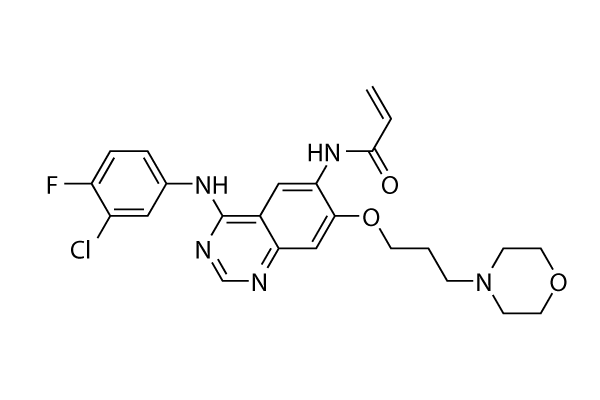| DC55130 |
CDK4 inhibitor compound 12
|
CDK4 inhibitor compound 12 is a novel inhibitor of CDK4 with the activity 97 μM. |
| DC73181 |
XPW1
|
XPW1 is a potent and selective CDK9 inhibitor with excellent anti-ccRCC activity and low toxicity. |
| DC73170 |
GFH009
|
GFH009 is a potent, selective CDK9 inhibitor, inhibits the activity of the CDK9/cyclin T1 regulatory complex of P-TEFb. |
| DC70984 |
(S)-CR8
|
(S)-CR8 is the S-isomer of CR8. (S)-CR8 is a potent and selective CDK inhibitor with IC50s of 0.060, 0.080, 0.11, 0.12, and 0.15 μM for CDK2/cyclin E, CDK2/cyclin A, CDK9/cyclin T, CDK5/p25, and CDK1/cyclin B, respectively. (S)-CR8 reduces SH-SY5Y cells survival (IC50 0.40 μM). |
| DC70766 |
Senexin C
|
Senexin C is a novel potent, selective and orally bioavailable CDK8/19 inhibitor with Kd of 1.4 and 2.9 nM for CDK8/CycC and CDK19/CycC, respectively.Senexin C inhibits CDK8/CycC with IC50 of 3.6 nM, shows high selectivity against other HDAC isoforms.Senexin C is more metabolically stable and provides a more sustained inhibition of CDK8/19-dependent cellular gene expression when compared with the prototype inhibitor Senexin B.Senexin C inhibits MV4-11 leukemia growth in a systemic in vivo model with good tolerability. |
| DC70298 |
CDDD11-8
|
CDDD11-8 is a potent CDK9 inhibitor co-targeting FLT3-ITD with Ki values of 8 and 13 nM, respectively.CDDD11-8 displays excellent kinome selectivity in a panel of 369 human kinases.CDDD11-8 displays antiproliferative activity against leukemia cell lines, and particularly potent effects against MV4-11 and MOLM-13 cells, which are known to harbor the FLT3-ITD mutation and mixed lineage leukemia (MLL) fusion proteins.CDDD11-8 causes a robust tumor growth inhibition by oral administration in animal xenografts, induces tumor regression at dose of 125 mg/kg. |
| DC70230 |
AZ5576
|
AZ5576 (AZ-5576) is a potent, selective CDK9 inhibitor with an IC 50 <5 nM, decreases phosphorlyation of Ser2-RNAPII in cells with an IC 50 of 96 nM.AZ5576 downregulated Mcl-1 and MYC protein abundance across multiple tested DLBCL cell lines and in primary DLBCL cells.MYC sensitizes DLBCL cells to AZ5576, genetic downregulation of MYC in U-2932 and OCI-LY19 cells resulted in diminished susceptibility to AZ5576.AZ5576 dose-dependently downregulated MYC transcription of a luciferase reporter containing multiple canonical MYC-MAX-binding sites, an effect more pronounced compared with multi-CDK inhibitor dinaciclib.AZ5576 restricts growth of xenografted DLBCL tumors in vivo. |
| DC50186 |
5,6-Dichlorobenzimidazole riboside(DBR)
|
5,6-Dichlorobenzimidazole riboside is a nucleoside analog that inhibits several carboxyl-terminal domain (CTD) kinases including casein kinase II and CDKs. 5,6-Dichlorobenzimidazole riboside trigger p53-dependent apoptosis of human colon adenocarcinoma cells without inducing genotoxic stress to healthy cells. |
| DC47269 |
Samuraciclib
|
Samuraciclib (CT7001) is a potent, selective, ATP-competitive and orally active CDK7 inhibitor, with an IC50 of 41 nM. Samuraciclib displays 45-, 15-, 230- and 30-fold selectivity over CDK1, CDK2 (IC50 of 578 nM), CDK5 and CDK9, respectively. Samuraciclib inhibits the growth of breast cancer cell lines with GI50 values between 0.2-0.3 µM. Samuraciclib has anti-tumor effects. |
| DC47048 |
Rebamipide mofetil
|
Rebamipide mofetil is an orally active prodrug of Rebamipide (OPC12759). Rebamipide is a mucoprotective agent. Rebamipide induces COX-2 expression, increases PGE2 levels, and enhances gastric mucosal defense in a COX-2-dependent manner. |






















